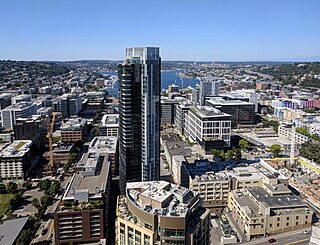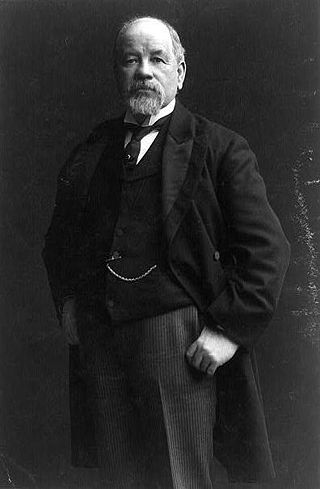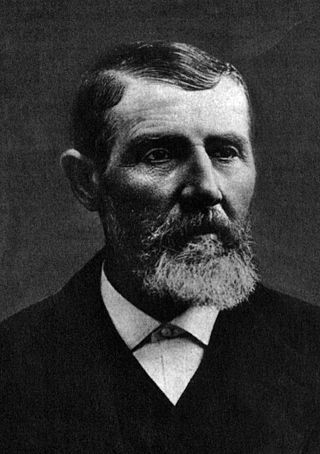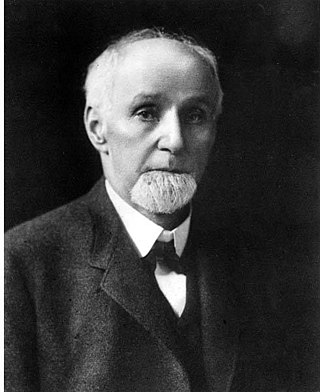
Chief Seattle was a Suquamish and Duwamish chief. A leading figure among his people, he pursued a path of accommodation to white settlers, forming a personal relationship with "Doc" Maynard. The city of Seattle, in the U.S. state of Washington, was named after him. A widely publicized speech arguing in favour of ecological responsibility and respect of Native Americans' land rights had been attributed to him.

David Swinson "Doc" Maynard was an American pioneer, doctor, and businessman. He was one of Seattle's primary founders. He was an effective civic booster and, compared to other white settlers, a relative advocate of Native American rights. His friendship with Chief Seattle was important in the formation of the city of Seattle, and it was he who proposed the city be named for this important chief. Maynard was Seattle's first doctor, merchant prince, second lawyer, Sub-Indian Agent, Justice of the Peace, and architect of the Point Elliott Treaty of 1855.
Two conflicting perspectives exist for the early history of Seattle. There is the "establishment" view, which favors the centrality of the Denny Party, and Henry Yesler. A second, less didactic view, advanced particularly by historian Bill Speidel and others such as Murray Morgan, sees David Swinson "Doc" Maynard as a key figure, perhaps the key figure. In the late nineteenth century, when Seattle had become a thriving town, several members of the Denny Party still survived; they and many of their descendants were in local positions of power and influence. Maynard was about ten years older and died relatively young, so he was not around to make his own case. The Denny Party were generally conservative Methodists, teetotalers, Whigs and Republicans, while Maynard was a drinker and a Democrat. He felt that well-run prostitution could be a healthy part of a city's economy. He was also on friendly terms with the region's Native Americans, while many of the Denny Party were not. Thus Maynard was not on the best of terms with what became the Seattle Establishment, especially after the Puget Sound War. He was nearly written out of the city's history until Morgan's 1951 book Skid Road and Speidel's research in the 1960s and 1970s.

Alki Point is a point jutting into Puget Sound, the westernmost landform in the West Seattle district of Seattle, Washington. Alki is the peninsular neighborhood on Alki Point. Alki was the original settlement in what was to become the city of Seattle. It was part of the city of West Seattle from 1902 until that city's annexation by Seattle in 1907.

The Denny Party is a group of American pioneers credited with founding Seattle, Washington. They settled at Alki Point on November 13, 1851.

The Museum of History & Industry (MOHAI) is a history museum in the South Lake Union neighborhood of Seattle, Washington, United States. It is the largest private heritage organization in Washington state, maintaining a collection of nearly four million artifacts, photographs, and archival materials primarily focusing on Seattle and the greater Puget Sound region. A portion of this collection is on display in the museum's galleries at the historic Naval Reserve Armory in Lake Union Park.

Thomas Minor Pelly was an American politician. He served as a U.S. Representative from the state of Washington between 1953 and 1973.

South Lake Union is a neighborhood in Seattle, Washington, so named because it is at the southern tip of Lake Union.

Licton Springs or North College Park is a neighborhood in the informal Northgate district of North Seattle. It is bounded by Interstate 5 to the east, beyond which is Maple Leaf neighborhood and the Northgate Mall; Aurora Avenue N to the west, beyond which is Greenwood; N 85th Street to the south, beyond which is Green Lake, and N Northgate Way to the north, beyond which is Haller Lake.

Thomas Burke was an American lawyer, railroad builder, and judge who made his career in Seattle, Washington. He served as chief justice of the Supreme Court of the Washington Territory from 1888 to 1889. He was the main representative of railroad magnate James J. Hill in Seattle. Burke Avenue, The Burke-Gilman Trail and the Burke Museum are named in his honor.

Wawona was an American three-masted, fore-and-aft schooner that sailed from 1897 to 1947 as a lumber carrier and fishing vessel based in Puget Sound. She was one of the last survivors of the sailing schooners in the West Coast lumber trade to San Francisco from Washington, Oregon, and Northern California.

Arthur Armstrong Denny was one of the founders of Seattle, Washington, the leader of the pioneer Denny Party, and later the city's wealthiest citizen and a 9-term member of the territorial legislature. Seattle's former Denny Hill was named after him; it was flattened in a series of regrading projects and its former site is now known as the Denny Regrade. The city's Denny Way, however, is named not after Arthur Denny, but after his younger brother David Denny.

Carson Dobbins Boren was an early founder of Seattle, Washington. His sister Mary Ann was married to Arthur Denny, and his sister Louisa to David Denny. Boren was the first King County Sheriff. Seattle's Boren Avenue is named in his honor.

Cheshiahud and his family on Lake Union, Seattle, Washington in the 1880s are, along with Princess Angeline, among the few late-19th century Dkhw'Duw'Absh about whom a little is known. In the University of Washington (UW) Library image archives, he is called Chudups John or Lake Union John. His family were among the few of the Duwamish people who did not move from Seattle to the Port Madison Reservation or other reservations. They lived on Portage Bay, part of Lake Union, when a photo was taken around 1885. According to the Duwamish Tribe, Lake John had a cabin and potato patch at the foot of Shelby Street. A commemorative plaque of unknown reliability is said to exist at the eastern foot of Shelby. This land was given to him by Seattle pioneer David Denny or the property was purchased—see below. Photographer Orion O. Denny recorded Old Tom and Madeline, ca. 1904, further noted in the UW Library archives as Madeline and Old John, also known as Indian John or Cheshishon, who had a house on Portage Bay in the 1900s, south of what is now the UW campus although native people had been prohibited from residence in Seattle since the mid-1860s.
The Duwamish tribe is a Native American tribe in western Washington, and the indigenous people of metropolitan Seattle. The Duwamish tribe today includes the People of the Inside (Dxw'Dəw?Abš), for Elliott Bay environs today; and the People of the Large Lake (Xacuabš), for those around Lake Washington of today.

David Thomas Denny was a member of the Denny Party, who are generally collectively credited as the founders of Seattle, Washington, USA. Though he ultimately underwent bankruptcy, he was a significant contributor to the shape of the city. Roger Sale, in his book Seattle, Past to Present, described him as having been "the pioneer to turn to if one had a plan that would be 'good for Seattle', and one needed a respectable tone and a willing investor."

Dexter Horton was the founder of the first bank in the city of Seattle. Before his founding of the Bank of Dexter Horton in 1870 financial transactions were conducted by merchants.
The Puget Sound Maritime Historical Society (PSMHS) is located in Seattle, WA.

Evergreen Washelli Memorial Park originated in 1885. It is located on both sides of Aurora Avenue in Seattle, Washington, and occupies roughly 144 acres. It is the largest cemetery in Seattle.
Sellen Construction is a Seattle, Washington-based construction firm. Its clients have included Microsoft, Amazon.com, AT&T, Russell Investments, The Bill and Melinda Gates Foundation, Seattle Children's Hospital, and Vulcan Inc.

















